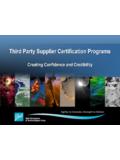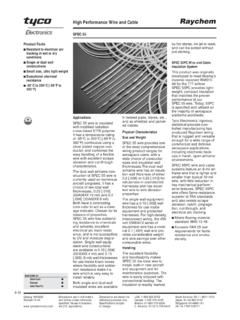Transcription of Edward de Bono’s SIX THINKING HATS - PMI Kerala
1 Edward de Bono's SIX THINKING hats . KS Mathew Professor, Department of CSE. 1. Agenda Dr. Edward de Bono Traditional THINKING What is Parallel THINKING ? Traditional THINKING vs. Parallel THINKING What is Lateral THINKING ? Introduction to Six THINKING hats method How to apply Six THINKING hats method Benefits of Six THINKING hats method Six THINKING hats method Case Studies Six THINKING hats method A Mock Session Questions & Answers 2. Dr. Edward de Bono Born in Malta in 1933. , , (medicine & psychology). Faculty at the universities of Oxford, London, Cambridge and Harvard World-renowned consultant to business, governments, schools and industry Author of 62 books in 47 languages Originator of the following: Direct teaching of THINKING as a skill (CoRT.)
2 Cognitive Research Trust - THINKING Programme). Lateral THINKING (1967). Parallel THINKING (1985). Six THINKING hats (1985). 3. Traditional THINKING Traditional THINKING is 2400 years old, based on the philosophies of Socrates, Plato and Aristotle Socrates used to point out what was wrong' to clarify the concepts Plato believed that we can see only shadows of truth as we go through life Aristotle believed that people would put together different boxes' in their mind based on their experience & judge things into one of those boxes So, traditional THINKING is concerned with what is which is determined by analysis, judgment & argument. It is not constructive or creative and doesn't involve design.
3 It is also called argument', adversarial', or western'. THINKING Partial exploration of subject / problem Involves analysis, judgment and argument There is no focus and thinks about too many aspects /. things at a time Traditional THINKING is not collaborative or cooperative 4. What is Parallel THINKING ? Team Members Focus (subject Focusor Team Members problem being Team Members discussed). Team Members Team Members All members look in the same direction at any moment Direction changes one after other All views are put down in parallel 5. Traditional vs Parallel THINKING Traditional THINKING Parallel THINKING Also called argument', First published by Edward de adversarial', or western' Bono in 1985.
4 THINKING Full exploration of subject /. 2400 years old based on problem philosophies of Socrates, Plato Concerned with what can and Aristotle be'. Involves constructive Partial exploration of subject / THINKING , creative THINKING problem and designing a way Concerned with what is' forward'. Involves analysis, judgment Deals with only one aspect /. and argument thing at a time Thinks about too many aspects / things at a time A. B. 6. What is Lateral THINKING ? Lateral THINKING means THINKING differently or THINKING out of the box. See the popular lateral THINKING puzzles below: Puzzle 1: Three switches outside a windowless room are connected to three light bulbs inside the room.
5 How can you determine which switch is connected to which bulb if you may enter the room only once? Answer: Switch one light on for a minute; turn it off and turn another on. Go into the room and feel the off bulbs. The warm bulb is connected to the first switch, the on- bulb is connected to the second and the cold bulb is connected to the third switch. Puzzle 2: A man is replacing a wheel on his car, when he accidentally drops the four nuts used to hold the wheel on the car, and they fall into a deep drain, irretrievably lost. A passing girl offers him a solution which enables him to drive home. What is it? Answer: Use one nut from each of the other three wheels.
6 Puzzle 3: A truck is stuck at a road under a bridge. It's just a couple of inches too high to pass under. Any other route, avoiding the bridge would add a couple of hours to the journey. A young boy comes along and again saves the day. How? Answer: Let air out of the tires till the truck is low enough. 7. What is Lateral THINKING ? ( ). Puzzle 4: A man lives on the tenth floor of a building. Every day he takes the elevator to go down to the ground floor to go to work. When he returns he takes the elevator to the 7th floor and walks up the stairs to reach his apartment on the 10th floor. He hates walking so why does he do it? Clue: on rainy days he goes up in the elevator to the tenth floor.
7 Answer: The man is dwarf and can only reach the button for the 7th floor. On rainy days he uses his umbrella! Puzzle 5: A landlord is threatening to evict a father and his beautiful young daughter, unless she agrees to marry him. In a false gesture of sincerity, he offers her an opportunity for her and her father to remain in the house, without marrying him. He has a silk bag in which he says he has placed a white and a black stone from the footpath on which they're standing. If she picks the white stone from the bag, without looking, she wins; if she picks the black, she loses. However, the young girl saw him place two black stones in the bag. She can't expose him in front of the witnesses without angering him and making things worse.
8 How does the clever girl win? Answer: She withdraws a stone and instantly drops it into those on the ground and is lost. To know what color it was, they must look at the stones remaining in the bag. 8. Introduction to Six THINKING hats A method for effective team meetings, problem solving, decision making and proposal/design evaluation A method based on the concept of parallel THINKING Can be used in businesses, schools and families for resolving issues and making decisions Major organizations using Six THINKING hats are: NASA, IBM, ABB, Siemens, Microsoft, British Airways, BP, Statoil, NTT, Federal Express, Polaroid, Pepsico, DuPont, Prudential Insurance etc. 9.
9 Introduction to Six THINKING hats Can be used by businessmen, professionals, teachers, students, children or individuals. There are six different color imaginary hats that you can put on or take off. hats help a group to use parallel THINKING Color of hat identifies the type or direction of THINKING The main idea is to have the group wear only one hat at a time 10. Six THINKING hats Hat Color Represents Function of Hat Neutral, Objective Objective Facts & Figures Emotional, Angry Emotions & Feelings Serious, Sombre Cautious & Careful Sunny, Positive Optimistic, Hope & Positive THINKING Growth, Fertility Creativity, Ideas & Lateral THINKING Cool, Sky Above Control & Organization of THINKING 11.
10 White Hat THINKING Neutral, objective information Facts & figures Two tiers of facts - Believed Facts & Checked Facts Excludes ones own opinions, hunches, judgments Removes feelings & impressions Report of opinion of someone else Questions to be asked & answered under White hat: What information / facts do we know? What information is missing? What information / facts would we like to have? How are we going to get the information? What is relevant? What is most important? 12. How valid is this? Red Hat THINKING Emotions & feelings influence THINKING & red hat acknowledges this fact Emotions come in three ways: Background emotions such as fear, anger, hatred, love etc.






